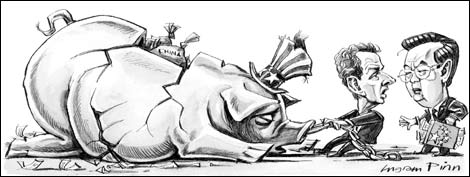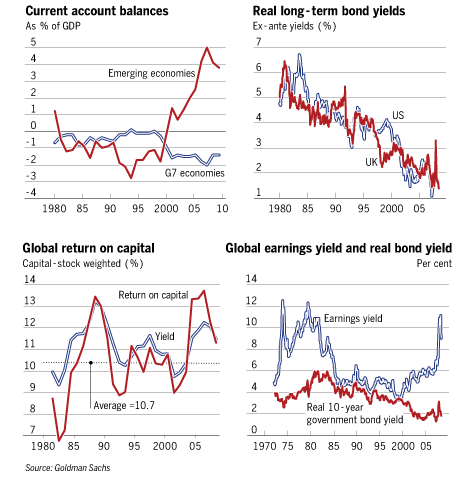By Martin Wolf
Published: June 9 2009 19:06 | Last updated: June 9 2009 22:52

Creditor countries are worrying about the safety of their money. That is what links two of the big economic stories of last week: Chancellor Angela Merkel’s attack on the monetary policies pursued by central banks, including her own, the European Central Bank; and the pressure on Tim Geithner, US Treasury secretary, to persuade his hosts in Beijing that their claims on his government are safe. But are they? The answer is: only if the creditor countries facilitate adjustment in the global balance of payments. Debtor countries will either export their way out of this crisis or be driven towards some sort of default. Creditors have to choose which.
Germany and China have much in common: they have the world’s two biggest current account surpluses, at $235bn and $440bn, respectively, in 2008; and both are also powerhouses of manufactured exports. They have, as a result, suffered from the collapse in demand of overindebted purchasers of their exports. So both feel badly done by. Why, they ask themselves, should their virtuous people suffer because their customers have let themselves go so broke?
Germany and China are also very different: Germany is a highly competitive global producer of manufactures. But it is also a regional power that has shared its money with its neighbours since 1999. Its problem is that its surpluses were offset by its neighbours’ largely private excess spending. Now that the borrowers are bankrupt, their countries’ domestic demand is collapsing. This is leading to a huge expansion in fiscal deficits and pressure for easier monetary policies from the ECB. So Ms Merkel is driven towards undermining the independence of Germany’s central bank, in order to protect the still more vital goal of monetary stability.
Germany may be Europe’s pivotal economy. But China is a nascent superpower. Without intending to do so, it has already shaken the world economy. Incorporating this dynamic colossus into the world economy involves huge adjustments. This is already evident in any discussion of a sustained exit from the crisis.
A recent paper from Goldman Sachs – unfortunately, not publicly available – sheds fascinating light on the impact of China’s rise on the world economy.* In particular, it broadens the analysis of the role of the “global imbalances”, on which I (and many others) have written.

The paper points to four salient features of the world economy during this decade: a huge increase in global current account imbalances (with, in particular, the emergence of huge surpluses in emerging economies); a global decline in nominal and real yields on all forms of debt; an increase in global returns on physical capital; and an increase in the “equity risk premium” – the gap between the earnings yield on equities and the real yield on bonds. I would add to this list the strong downward pressure on the dollar prices of many manufactured goods.
The paper argues that the standard “global savings glut” hypothesis helps explain the first two facts. Indeed, it notes that a popular alternative – a too loose monetary policy – fails to explain persistently low long-term real rates. But, it adds, this fails to explain the third and fourth (or my fifth) features.
The paper argues that a massive increase in the effective global labour supply and the extreme risk aversion of the emerging world’s new creditors explains the third and fourth feature. As the paper notes, “the accumulation of net overseas assets has been entirely accounted for by public sector acquisitions ... and has been principally channelled into reserves”. Asian emerging economies – China, above all – have dominated such flows.
The huge capital outflows were the consequence of policy decisions, of which the exchange-rate regime was the most important. The decision to keep the exchange rate down also put a lid on the dollar prices of many manufactures. I would add that the bursting of the stock market bubble in 2000 also increased the perceived riskiness of equities and so increased the attractions of the supposedly safe credit instruments whose burgeoning we saw in the 2000s. The pressure on wages may also have encouraged reliance on borrowing and so helped fuel the credit bubbles of the 2000s.
The authors conclude that the low bond yields caused by newly emerging savings gluts drove the crazy lending whose results we now see. With better regulation, the mess would have been smaller, as the International Monetary Fund rightly argues in its recent World Economic Outlook. But someone had to borrow this money. If it had not been households, who would have done so – governments, so running larger fiscal deficits, or corporations already flush with profits? This is as much a macroeconomic story as one of folly, greed and mis-regulation.
The story is not just history. It bears just as heavily on the world’s escape from the crisis. The dominant feature of today’s economy is that erstwhile private borrowers are, to put it bluntly, bust. To sustain spending, central banks are being driven towards the monetary emissions of which Ms Merkel is suspicious and governments are driven towards massive dis-saving, to offset higher desired private saving.
Today, Germany wants to preserve the value of its money, while China is desperate to preserve the value of its external assets. These are understandable aims. Yet, if this is to happen, debtor countries have to stabilise their economies without another round of profligate private borrowing or an indefinite rise in government debt. Both paths will ultimately lead to defaults, inflation, or both and so to losses for creditors. The only alternative is for debtors to earn their way out. At the level of an entire country that means a big rise in net exports. But if indebted countries are to achieve this aim, in a vigorous world economy, the surplus countries must expand demand strongly, relative to supply.
China’s decision to accumulate roughly $2,000bn in foreign currency reserves was, in my view, a blunder. Now it has a choice. If it wants its claims on the US to be safe, it must facilitate an adjustment in the global balance of payments. If it and other surplus countries wish to run huge surpluses and accumulate vast financial claims, they should expect defaults. They cannot have both safe foreign assets and huge surpluses. They must choose between them. It may seem unfair. But whoever said life is fair?
martin.wolf@ft.com
More columns at www.ft.com/martinwolf
Read and post comments at Martin Wolf’s blog
*The Savings Glut, the Return on Capital and the Rise in Risk Aversion, May 27 2009
Copyright The Financial Times Limited 2009